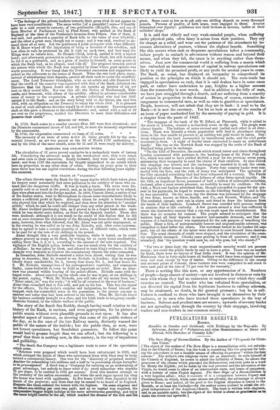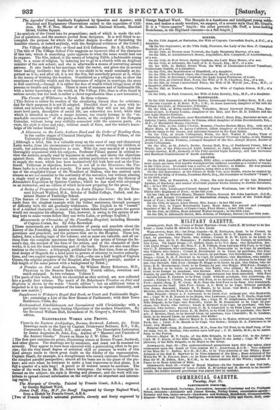PUBLICATIONS ILBCLEIV&D.
BOOKS.
.Ranibtes in Sweden and Gottlaud; with. Etchings by the Way side. By Sylvanus, Author of " Pedestrian and other Reminiscaneea at Home and Abroad, with Sketches of Country Life."
The Sure Hope of Reconciliation. By the Anther of " Proposals for Chris- thin Union."
[The object of the author of The Sure Hope is a reconciliation with, not subrolU- sion to the Church of Rome; but the book is something like the proposal for bell- ing the cat—there is not a feasible means of effecting itapurpose " within the four corners." The writer's own religions views are as uncertain: be calls himself of the Church of England, he seems to admit the fallibility of Rome, he allows the grossness of the abuses which preceded the Reformation, and even puts in a wont for Henry the Eighth; yet be-holds by the real presence and the invocation of the Virgin, he would seem to allow of an intermediate state, and hence of purgatory, with a variety of other Popish dogmas. The ,9ure Hope of a Recorwiliation is a very hopeless affair: what it consists of is a comparison between Popery and Protestantism, in which, while some abuses are:allowed, the advantage. is always given to Rome; and indeed, all thegood in the English churches is traced to tile Burnish, or at least the Catholic—for the author seems inclined to admit the ori- ginal independence of the Anglican Church. The book is written with elegance, and in an amiable spirit; bataheobject of the writer is aboatus practieable as to. Make the river* run npwards.1 228 Apostles' Creed, familiarly Explained by Question and Answer; with Practical and Explanatory Observations suited to the capacities of Chil- dren. By W. F. Slee, Master of St. James's National Schools, Marshall Street, Golden Square.
[An analysis of the Creed into its propositions; each of which is made the sub- ject of questions, and the answers proved from Scripture. It is well fitted to ac- complish the purpose for which the author designs it—that of furnishing the humIder classes, or indeed anybody, with the Scriptural evidences of the Creed.]
The Village School Fite; or Good and Evil Influences. By A. E. Challice. [The title of The Village School Fête suggests an incorrect idea of the character of this tale, which is something quite opposite to what the name would lead one to suppose. The fete, indeed, is the means of bringing Edith, a fashionable young lady, to a sense of religion, by inducing her to go to a church with an Anglican minister of the new school; and she is afterwards a means of converting several persons. It also leads to her marriage with the rector, and gives rise to several other leading incidents: but the fete is too slight to be made nominally so im- portant as it is; and after all, it is not the fete, but somebody present at it, which as the means of working the wonders. Considered as a religious tale, to show the emptiness of worldly wealth and the importance of religion in marriage, the story is well contrived,—though it is rather the loss of wealth which brings most of the persons to trouble and religion. There is more of manners and of fashionable life, with a better knowledge of the world, in The Village Fete, than is often found in" serious novels; but the book is rather a clever reproduction than a new invention.] The Curate of Wildrnere; a. Novel In three volumes. [This fiction is rather for readers of the circulating library than for criticism; and for their purposes it is not ill adapted. Provided there is a story with in- cident and interest, they will not say, for probably they will not see, that the more level parts, descriptive of social life, are somewhat too level; while that which is intended to excite a deeper interest, too clearly belongs to the "re- markable occurrences" of the penny-a-liners, or the compilers of the Newgate Calendar, without being very skilfully connected with the common parts. Au reste, the style is clear and easy, without much of force, and the writer's know- ledge of life rather limited.] A Discourse on the Latin Authors Read and the Order of Reading them, in the earlier stages of Classical Discipline. By Professor Pillans, of the University of Edinburgh. [Although a brief, this is a valuable essay on the want of easy and elementary Latin works, from the circumstance of the ancients never writing for children or youth, but addressing themselves to men. With the easy mastery of a teacher thoroughly acquainted with his subjects, Professor Pillans passes in critical re- view the authors usually read by beginners in schools, and shows the objections against them. He also throws out some curious particulars on the means taken to supply the want, which has been instinctively felt both here and on the Con- tinent. Criticism or objection, however, is not all in the Discourse; the Pro- fessor looks to a reform and a remedy. For mere beginners, he recommends the use of the simplified Caesar of Dr. Woodford of Madras, who has omitted such clauses as are not essential to the continuity of the narrative, but without altering a single word or phrase. For the next stage, he would employ the History of Alexander's Expedition by Quintus Corals; which he has used with advantage as an instructor, and an edition of which he is now preparing for the press.] A Series of Progressive Exercises in Latin Elegiac Verse. By the Reve- rend Edward Watford, MA., Scholar of Balliol College, Oxford, and As- sistant Master of Tunbridge SchooL [The feature of these exercises is their progressive character: the book pro- ceeds from the simplest example with the fullest assistance, through passes es of difficulty with the aid gradually withdrawn. The English to be " turned" is of a crabbed character; so much so that when taken from our poets the parent would not recognize his offspring. This, however, is owing to the system of set- ting boys to make verses before they can write Latin, or perhaps English.] Memoranda or Chronicles of the Foundling Hospital; including Memoirs of Captain Comm, &c. By John Brownlow.
[These memoranda are a pleasant collection of gossip and anecdote about the history of the Foundling, its interior economy, its various regulations, some of its governors and preachers, and the pictures that are in the Hospital. These last, =deed, form a leading topic of the volume; and as some are valuable, and all cu- rious from the complete specimens they furnish of the artists of George the Se- cond's day, the account of the lives of the artists, and of the character of their works, it is not the least interesting part of the book. There are also some illus- trations to the volume: a lithograph, published for the first time, from an allego- rical design of Hogarth for a head-piece to powers of attorney to receive subscrip- tions, and two capital engravings by Mr. Cook,—the one a half length of Captain Coram, the original projector of the Hospital, after Hogarth's portrait; another a fall-length of the same person with a background by Nebot.]
A Treatise on Diet and Regimen. By William Henry Robertson, M.D., Physician to the Buxton Bath Charity. Fourth edition, rewritten and much enlarged. In two volumes. Volume I. [The parts of this work, which we chronicled as they arrived, are now collected Into a goodly first volume. The merit of Dr. Robertson's Treatise on Diet and Regimen is shown by the words " fourth edition"; but an additional value is imparted to it by an incorporation of the late discoveries in organic chemistry, and other new matter.] Supplement to Webster's Royal Red Book, or Court and Fashionable Regis- ter: containing a List of the New Houses of Parliament; with their Town Residences, Clubs, &c.
Ecclesiastical Establishments not Inconsistent with Christianity; with a particular view to some leading Objections of the modern Dissenters. By the Reverend William Hull, Incumbent of St. Gregory's, Norwich. Third edition.
ILLUSTRATED WORKS AND Pnrarrs.
Views in the Eastern Archipelago, Borneo, Sarawak, Labuan, cfc. From
Drawings made on the Spot by Captain Drinkwater Bethune, RN., C.B.,
Commander L. G. John, R.N.and others. The Descriptive Letterpress by James Augustus St. ohn, Esq., Author of " Manners and Customs of the Ancient Greeks." Drawn on Stone by J. W. Giles. Part I.
[The first part contains six prints, illustrating scenes at Borneo Proper, Sariwak,
and other places. The drawings are by amateurs, and must not be scanned too severely. They appear to have been executed with a painstaking effort to be pre- cise; but the very small degree of artistical skill so common in works of this kind always tends to throw great doubt on the fidelity of the representation. Captain Heath, for example, is a draughtsman who cannot extricate himself from the simplest parallel perspective; almost all his boats are in the plane of the pic- ture; and once when he ventures to make a boat transverse to that plane, it is full a quarter of a mile long t A pencil so ill trained cannot be accurate. The value of the work lies in Mr. St. John's letterpress: the writer is thoroughly in- formed on the subject; his style is flowing and pleasant; and the work will con- tribute to spread correct information on the subject of an important and interest- ing region.] The Marquis of Granby. Painted by Francis Grant, A.RA.; engraved by George Raphael Ward. James Duff, Esq., M.P. for Banff. Engraved by George Raphael Ward, from a Sketch by Francis Grant, A.R.A.
[Two of Francis Grant's animated portiaits, cleverly and freely engraved by George Raphael Ward. The Marquis is a handsome and intelligent young noble.. man, and makes a study worthier, we suspect, of a severer style than Mr. Grant's. It is a "three-quarter" length: the other rtrait—Mr. Duff, a keen-looking Scotrhmsn, in the Highland costume—is a full-length.]



























 Previous page
Previous page